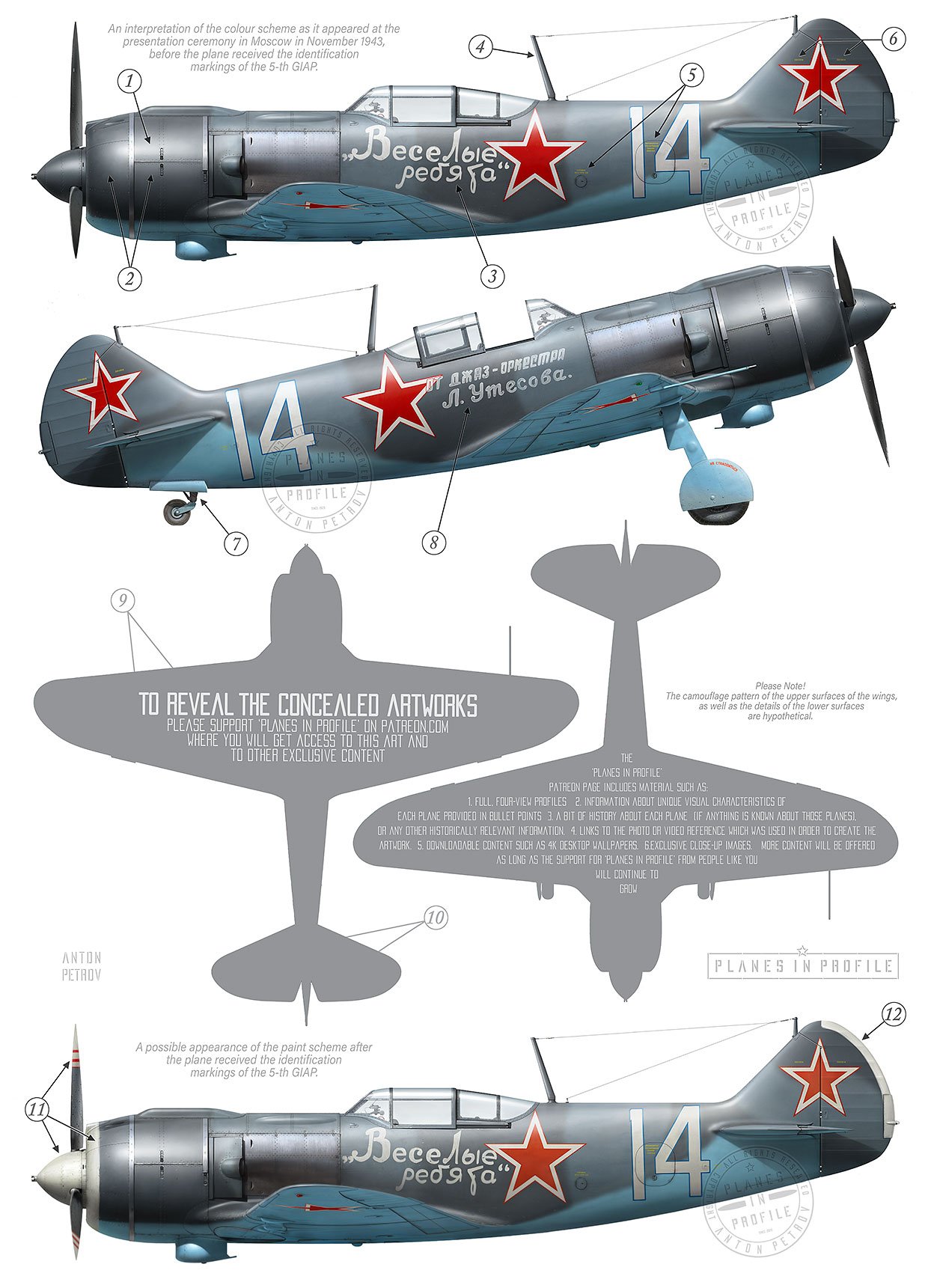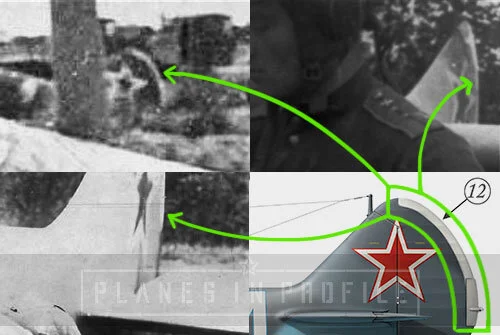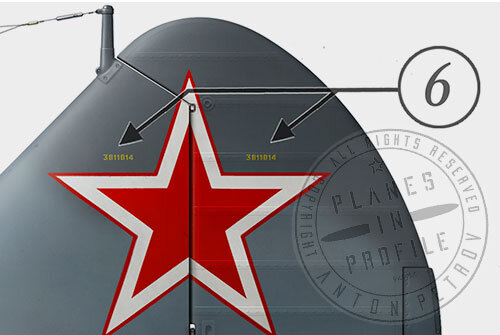“Veseliye Rebyata” white-14
Lavochkin, La-5F (Type 39)
1-st Squadron (The Singing Squadron), 5-th GIAP (‘Berlinskiy’ regiment) , 11-th GIAD. Presented during a ceremony in Moscow in November 1943 (Or March 1944, depending on the source)
Flown by various elite pilots of the 5-th GIAP, including Alexandr Borisovich Masterkov (An ace with 17 (15personal +2 shared victories))
‘Veseliye Rebyata’ (Jolly Fellows) are two airplanes (White-12 and White-14) which are associated with a few aspects of the Soviet pop culture. First is that they are named after a 1939 movie called ‘Veseliye Rebyata’ . This was a Jazz comedy staring a Soviet musician/actor- Leonid Utesov and his Jazz band. The movie popularised its theme song called ‘ Legko na serdtse ot pesni veseloy’ (The heart feels light from a jolly song) and this was a song that was sometimes sung by the pilots of the 1-st squadron of the 5th GIAP many of whom were keen musicians themselves and who often entertained their comrades by performing empromptu concerts. For their musical skills they were nicknamed ‘The singing squadron’ and it is said that some of their airplanes (Possibly including ‘ White-12’ ?) featured the notes of the song ‘Veseliye Rebyata’ on their fuselage. For example, as has been interpreted in the movie ‘V Boy Idut Odni Stariki’ .
Utesov’s band performed many free concerts at the front in their support for the war effort, including concerts performed for the 5th GIAP. In 1943 the band went a step further in their support for the war effort and purchased two La-5F Planes which they gifted to the Singing Squardon of the 5-ht GIAP, along with a record player and a collection of records (The latter were gifted by Utesov’s daughter Edith Utesova). The gifting ceremony took place on Moskow’s central airfield ( named after ‘Frunze’). When Utesov with his band and daughter presented these gifts at the ceremony, he wished that the pilots of the 5-th GIAP would: “fly to Hitler’s lair on the wings of the ‘Jolly Fellows’ “. His wish was fulfilled when in the following years his ‘Jolly Fellows’ helped the 5-th GIAP to fight the Germans all the way back to Germany and took part in the storming of “Hitler’s Lair”- Berlin itself (Well, at least the ‘White-12’ did) , performing the latter task so effectively that the regiment received the title of ‘Berlinskiy’!
After the gifting ceremony, the planes were flown from Moscow to the front lines by two experienced pilots of 5-th GIAP - deputy regiment commander for political affairs Victor Petrovich Rulin and one of the best fighter pilots of the regiment - Alexandr Masterkov [1] (one of the streets in Moscow is named after him). When the planes arrived at the front they were assigned to the squadron of the senior leutenant Vitaliy Popkov who was nicknamed ‘Maestro’ after the main character in the movie ‘Veseliye Rebyata’ played by Utesov. This squadron consisted of elite fighter pilots, mostly from Moscow. Especially outstanding in air battles were Aleksandr Masterkov, Sergey Glinkin, Ivan Sytov (who was shot down and died a month prior) and the commander of the squadron Vitaliy Popkov himself [2]. Out of 14 pilots in the squadron, 11 were eventually awarded the title of the Hero Of the Soviet Union[3] - the country’s highest honour. The ‘Veseliye Rebyata’ planes were allowed to be flown by only the best pilots and each of the pilots considered it an honour to fly them into battle.
Three months after receiving the airplanes, the pilots of the 5thGIAP wrote a letter to Utesov and his band, saying:
"Since receiving your gift, the guardsmen-pilots have destroyed nine enemy aircraft in aerial battles and on airfields. There is no doubt that this score will keep growing. Your machines are in good hands. They will continue to be a threat to the Nazis."[4]
Another connection that the ‘Jolly Fellows’ airplanes have to the Soviet pop culture is that in 1973 a very popular movie came out which was loosely based on the stories and the pilots of the ‘Singing Squadron’ . This Soviet classic is called ‘V Boy Idut Odni Stariki’ which translates to ‘Only the old men go to battle’. The title of the movie implies that only the experienced pilots “old men” were allowed to engage in air battles in the 5th GIAP, which is partly why this regiment finished the war with relatively fewer casualties than many other regiments. Unfortunately, since the movie was only inspired by the ‘Singing squadron’ and isn’t explicitly about this particular squadron, the airplanes used in the movie are not replicas of the airplanes that the ‘Singing Squadron’ flew during the war. Had they been exact replicas then undoubtedly White-12 and White-14 would have featured prominently in the film, because in real life these planes became a very special part of the squadron for the rest of the war.
‘White-14’ (and White-12) were highly regarded by the pilots of the 5-th GIAP. These planes might have been a ‘lightened’ version of the La-5F(meaning that they had duralumin wing spars) which increased their performance characteristics. Such La-5F and La-5FN planes were produced in small numbers and were intended to be flown only by the best pilots. But even though ‘White-14’ was flown by some of the best in the 5-th GIAP, it wasn’t lucky enough to survive the war. According to some sources it was destroyed by Flak fire on the 20th of March 1945 (only a couple of weeks before the end of the war) near the town of Bautzen in Germany, killing a famous Soviet fighter ace Alexandr Masterkov who piloted it at the time. Masterkov (who by that time was credited with 15 personal victories) jumped out of the burning ‘Jolly Fellow’, but his parachute was caught on the tail of the falling ‘White-14’, dragging Masterkov to die with it. Other sources (Aleksandr Stankov) claim that White-14 was heavily damaged during a landing in 1944, while piloted by senior leutenant Ignatiev.
Noteworthy visual characteristics
1) Note the absence of the ‘F’ logo which usually appears on the engine cowling in the area indicated by the arrow, as well as at the top of the tail.
2) The engine cowling seems to be covered with AMT-12 all over. This is a deviation from the standard camouflage pattern introduced in 1943. Infact, the camo pattern of ‘V.R. White-14’ is not perfectly consistent with either the usual ‘Grey-Grey’ nor the ‘Green-Black’ camo pattern standards. It’s partly for this reason that the colour of this airplane has sometimes been interpreted as Grey (By people such as Miloš Veštšík) and sometimes as Green (By people such as Aleksandr Stankov). Both of the fore-mentioned individuals claim to have spoken with V. Popkov (A famed Soviet pilot who flew the ‘Veseliye Rebyata’ planes) and both had their art signed personally by Popkov, though the art varies in colour. It’s difficult to know which sources to trust. Based on the design of the stars (With the white/red border), the camouflage pattern on the side of the plane, and the fact that these planes (White-12 and White-14) were built in late 1943 or early 1944, suggests that ‘White-14’ was most probably painted in accordance with the 1943 Grey-Grey camo pattern, as opposed to the Green-Black pattern of 1941.
3) ‘Веселые ребята’ (Veseliye rebyata) translates to ‘Jolly Fellows’. This is a title of a popular Soviet jazz comedy starring Leonid Utesov. It is also a title of one of Utesov’s Jazz albums. It was an appropriate slogan to appear on the two airplanes purchased and gifted to the 5-th GIAP by Utesov and his band.
4) The antena mast looks slightly more pointy than usual. This, along with a few other minor variations such as this, seems to be one of the features common to the planes built at factory number 381, which produced 239 out of the 4147 La-5F planes.
5) The technical markings are very hard to see in the black and white photographs. This might be because they were yellow rather than the usual white, it’s also possible that they were completely absent.
6) According to Alexander Stankov, the serial number of this plane was 3811014. This is based on a double-page spread he posted here: https://www.facebook.com/photo?fbid=825361680972487&set=a.356457884529538. This is consistent with the claims that the gifting ceremony took place in March 1944 (22 of March to be precise). This serial number does appear in the list of serial numbers of the airplanes built by factory 381 which can be found HERE
However, most sources I found claim that the ceremony took place in November 1944. After having consulted Miloš Veštšík (An expert on Lavochkin planes) about this, I was told that if the ceremony took place in November 1943 then it’s unlikely that the serial number was 3811014. This is because this serial number indicates that White-14 was a series 10 airplane, but series 10 La-5Fs of factory 381 were not produced before February 1944. The ‘series’ number is usually the second to last two digit numbers in the serial number, indicated in bold here - 3811014. Miloš informed me that if these planes were gifted to the 5-th GIAP in November 1943 that means that they were produced sometime before November 1943. By November 1943 factory number 381 had only produced series 01 to 05 La-5F machines, not series 10 machines. If we will presume that White 14 was produced in October 1943 (a month before it was gifted to the 5-th GIAP) then its series number was probably 04, which follows that its serial number should be 3810414.
In my artwork, I have tentatively used a serial number 3811014, as per A.Stankov’s claim. If anyone reading this can confirm the exact series number of this plane and is able to back their claim with some evidence then please leave a comment in the comments section below.
7) The suspension mechanism of the tail wheel had a cover around it.
8) От джаз-оркестра Л.Утесова (Ot djaz-orkestra L.Utesova) translates to ‘From the jazz-orchestra of L.Utesov ’.
9) On Patreon
10) On Patreon
An interpretation of how White-14 might have looked after it received the identification markings of the 5-th GIAP.
11) The tips of the propeller blades on the La-5F planes of the 5-th GIAP seem to have been striped, as can be seen in this photograph of Popkov in front of a La-5 or this photo of P.T. Kalsin for example. Note that the white stripes seem to be separated by another colour, clearly visible in the photo with Popkov, most likely red - based on its tone in the b/w photos. The tone of the “red” is darker than the propeller blades. In the photo of Kalsin we see that the blades are painted a lighter colour, possibly AMT-11. The propeller blades of the plane in the photo with Popkov were probably painted the same (lighter) colour too, which is why the “red ” appears darker than the blades. In my artwork I painted the propeller blades a lighter grey also to keep them consistent with the two photos I just mentioned.
In these same photos, as well as in many other photos of the Lavochkins of the 5-th GIAP, we can see that their spinner and the front of the engine cowling were painted white- these were the identification markings of the 5-th GIAP.
Please note that the markings indicated by ‘11’ are hypothetical, they are based on the photos of other La-5Fs of the 5-th GIAP.
12) Lavochkins of the 5-th GIAP probably had a white line painted along the trailing edge of the rudder, as can be seen in this image posted by ‘66misos’ on Massimo Tessitori’s website, and on many other images of La-5FNs of the 5-th GIAP where the tail is visible. In this same photo we can also see that Popkov’s plane in the foreground and the plane in the background both have two vertical stripes behind the main star on the fuselage. However, it doesn’t look like these stripes were present on the other planes of the 5-th GIAP and they don’t appear in the photos of ‘Veseliye rebyata’ White-12, at least not always (they might have been added at some later stage?), so I presume they also didn’t appear on White-14 (at least for some period of time).
Please note that the markings indicated by ‘12’ are hypothetical, they are based on the photos of other La-5Fs of the 5-th GIAP.
Here are a few closeup images to help illustrate the points above. Full set of closeup images is On Patreon
FOOTNOTES
[1] Info taken from the fifth paragraph of this article http://delovoy-m.ru/vse/item/1344-samolety-leonida-utesova
[2] Based on the info taken from the sixths paragraph of this article http://delovoy-m.ru/vse/item/1344-samolety-leonida-utesova
[3] It is what Popkov said in an article published here https://kp.ua/life/336421-yz-vospomynanyi-dvazhdy-heroia-sovetskoho-souiza-vytalyia-popkova-fylm-v-boi-ydut-odny-staryky-snialy-o-moei-eskadryle
[4] Taken from a book by Nikolay Illyin called ‘Guardsmen in the air’ https://libking.ru/books/nonf-/nonf-biography/23460-54-nikolay-ilin-gvardeytsy-v-vozduhe.html#book
LINKS TO THE REFERENCE IMAGES AND VIDEOS
http://ava.org.ru/iap/5g/la-5f-vr-1943.jpg
http://ava.org.ru/iap/5g/la-5f-vr1943.jpg
https://img51994.domkino.tv/img/2018-02-19/fmt_114_24_4.07utesovnasamolete6.jpeg
https://i173.photobucket.com/albums/w43/Renato71/wImage5.jpg
http://авиару.рф/wp-content/uploads/2015/09/5b.Leonid-Utesov-na-kryle-istrebitelya-La-5F..jpg
All the work presented on this is page is subject to updates and revisions in the light of new information which might present itself. If you have any new information relevant to this page or disagree with anything that's presented here, then please feel free to contact me through the Planes in Profile Facebook page. Thanks:)





